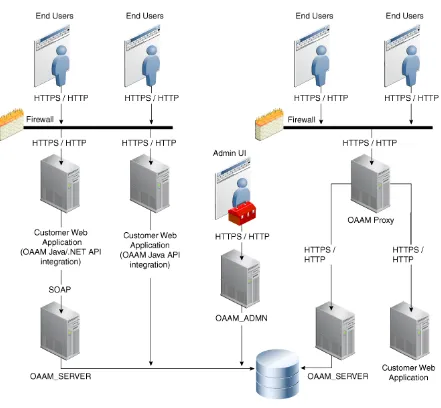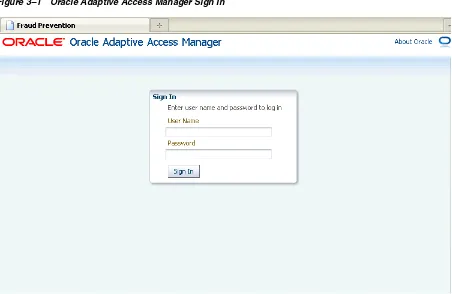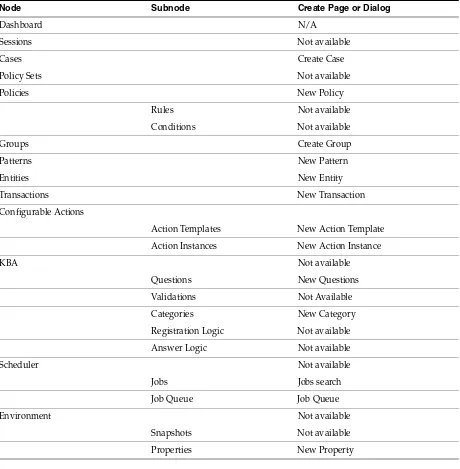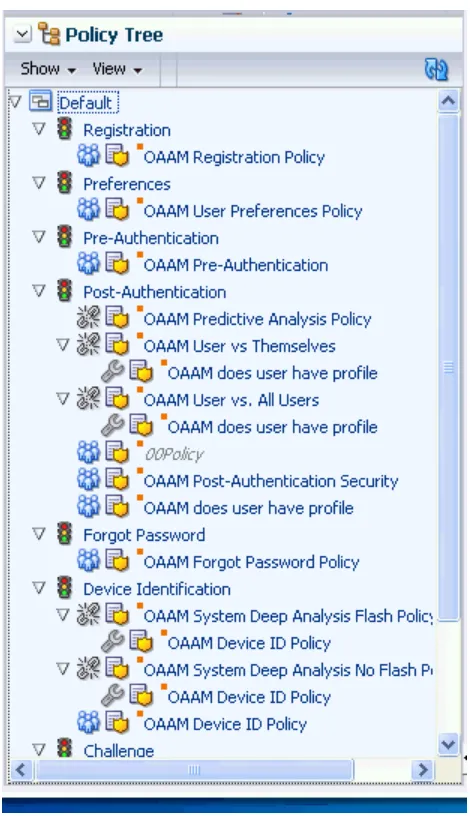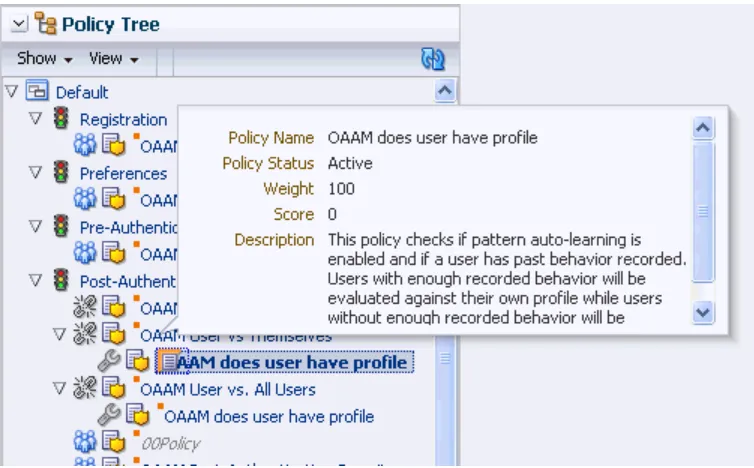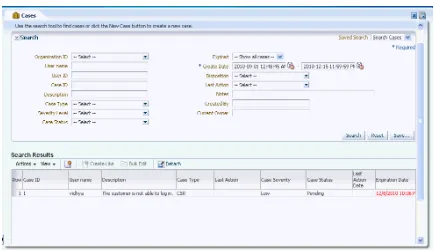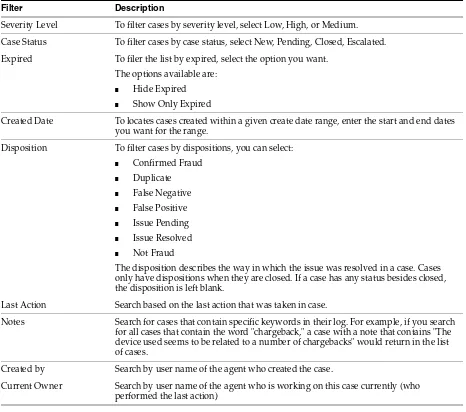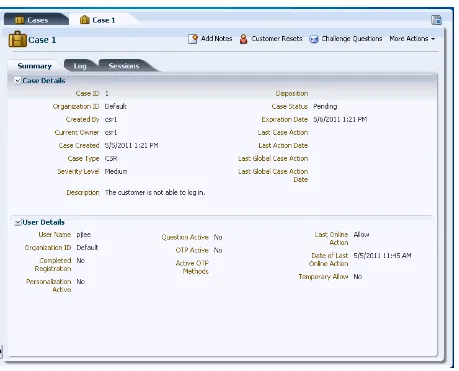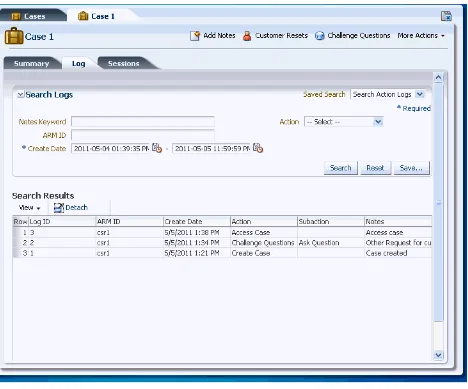Oracle® Fusion Middleware
Administrator's Guide for Oracle Adaptive Access Manager
Release 11
g
(11.1.1)
E14568-06
Oracle Fusion Middleware Administrator's Guide for Oracle Adaptive Access Manager, Release 11g (11.1.1) E14568-06
Copyright © 2010, 2011, Oracle and/or its affiliates. All rights reserved.
Primary Author: Priscilla Lee
Contributors: Niranjan Ananthapadmanabha, Mandar Bhatkhande, Sree Chitturi, Josh Davis, Jordan Douglas, Philomina Dorai, Daniel Joyce, Mark Karlstrand, Wei Jie Lee, Srinivas Nagandla, Paresh Raote, Jatin Rastogi, Jim Redfield, Nandini Subramani, Elangovan Subramanian, Vidhya Subramanian, Dawn Tyler, Sachin Vanungare, Saphia Yunaeva, and Xiaobin Zheng.
This software and related documentation are provided under a license agreement containing restrictions on use and disclosure and are protected by intellectual property laws. Except as expressly permitted in your license agreement or allowed by law, you may not use, copy, reproduce, translate, broadcast, modify, license, transmit, distribute, exhibit, perform, publish, or display any part, in any form, or by any means. Reverse engineering, disassembly, or decompilation of this software, unless required by law for interoperability, is prohibited.
The information contained herein is subject to change without notice and is not warranted to be error-free. If you find any errors, please report them to us in writing.
If this is software or related documentation that is delivered to the U.S. Government or anyone licensing it on behalf of the U.S. Government, the following notice is applicable:
U.S. GOVERNMENT RIGHTS Programs, software, databases, and related documentation and technical data delivered to U.S. Government customers are "commercial computer software" or "commercial technical data" pursuant to the applicable Federal Acquisition Regulation and agency-specific supplemental regulations. As such, the use, duplication, disclosure, modification, and adaptation shall be subject to the restrictions and license terms set forth in the applicable Government contract, and, to the extent applicable by the terms of the Government contract, the additional rights set forth in FAR 52.227-19, Commercial Computer Software License (December 2007). Oracle America, Inc., 500 Oracle Parkway, Redwood City, CA 94065.
This software or hardware is developed for general use in a variety of information management applications. It is not developed or intended for use in any inherently dangerous applications, including applications that may create a risk of personal injury. If you use this software or hardware in dangerous applications, then you shall be responsible to take all appropriate fail-safe, backup, redundancy, and other measures to ensure its safe use. Oracle Corporation and its affiliates disclaim any liability for any damages caused by use of this software or hardware in dangerous applications.
Oracle and Java are registered trademarks of Oracle and/or its affiliates. Other names may be trademarks of their respective owners.
Intel and Intel Xeon are trademarks or registered trademarks of Intel Corporation. All SPARC trademarks are used under license and are trademarks or registered trademarks of SPARC International, Inc. AMD, Opteron, the AMD logo, and the AMD Opteron logo are trademarks or registered trademarks of Advanced Micro Devices. UNIX is a registered trademark of The Open Group.
Contents
Preface
... xviiAudience... xvii
Documentation Accessibility ... xvii
Related Documents ... xviii
Conventions ... xviii
What's New in Oracle Adaptive Access Manager 11
g
Release 1 (11.1.1)?
... xixNew Features for Oracle Adaptive Access Manager 11g Release 1 (11.1.1) ... xix
Feature Comparison Chart - Oracle Adaptive Access Manager 11g vs. Oracle Adaptive Access Man-ager 10g xxii
Concepts and Terminology Changes for Oracle Adaptive Access Manager 11g... xxiii
Part I
Getting Started with Oracle Adaptive Access Manager
1
Introduction to Oracle Adaptive Access Manager
1.1 Benefits of Oracle Adaptive Access Manager... 1-2 1.2 Oracle Adaptive Access Manager Features ... 1-3 1.3 Oracle Adaptive Access Manager Architecture ... 1-6 1.4 Deployment Options ... 1-6
2
Setting Up the Oracle Adaptive Access Manager Environment for the First
Time
3
Oracle Adaptive Access Manager Navigation
3.1 Signing In to Oracle Adaptive Access Manager 11g... 3-1 3.2 OAAM Admin Console and Controls ... 3-2
Part II
Customer Service and Forensics
4
Managing and Supporting CSR Cases
4.1 Introduction and Concepts ... 4-1 4.2 CSR and CSR Manager Role Permissions ... 4-4 4.3 Getting Started... 4-5 4.4 Cases Search Page ... 4-6 4.5 Case Details Page ... 4-8 4.6 Viewing Case Activity... 4-11 4.7 Viewing Customer's Sessions... 4-12 4.8 Creating a CSR Case ... 4-14 4.9 Performing Customer Resets... 4-17 4.10 Performing Challenge Question Resets ... 4-22 4.11 Enabling a Temporary Allow... 4-26 4.12 Performing Case Actions ... 4-27 4.13 Configuring Expiry Behavior for CSR Cases ... 4-33 4.14 Reporting... 4-33 4.15 Multitenancy... 4-33 4.16 Use Cases... 4-37 4.17 Best Practices and Recommendations... 4-42
5
Investigation Using Agent Cases
5.12 Best Practices and Recommendations... 5-42
6
Viewing Additional Details for Investigation
6.1 Details Pages Overview ... 6-1 6.2 Details Page Structure ... 6-1 6.3 Prerequisites ... 6-2 6.4 Searching for Sessions ... 6-2 6.5 Export Sessions to Excel... 6-5 6.6 Add to Group ... 6-5 6.7 Session Details Page ... 6-9 6.8 Looking at Events from a Higher Level with Session Details ... 6-10 6.9 Investigation and the Importance of Details Pages ... 6-14 6.10 Viewing Alerts... 6-17 6.11 User Details Page ... 6-17 6.12 IP or Locations (Country, State, or City) Details Page... 6-34 6.13 Device Details Page ... 6-45 6.14 Browser or Flash Fingerprint Details ... 6-54 6.15 Alert Details Page ... 6-63 6.16 Uses Cases... 6-73
Part III
Managing KBA and OTP
7
Managing Knowledge-Based Authentication
7.1 Introduction and Concepts ... 7-1 7.2 Setting Up KBA Overview... 7-9 7.3 Setting Up the System to Use Challenge Questions ... 7-12 7.4 Accessing Configurations in KBA Administration... 7-13 7.5 Managing Challenge Questions... 7-13 7.6 Setting Up Validations for Answer Registration... 7-20 7.7 Managing Categories... 7-24 7.8 Configuring the Registration Logic... 7-27 7.9 Adjusting Answer Logic ... 7-28 7.10 Customizing English Abbreviations and Equivalences ... 7-33 7.11 Customizing Abbreviations and Equivalences for Locales ... 7-35 7.12 Use Cases... 7-35 7.13 KBA Guidelines and Recommended Requirements... 7-38
8
Enabling Challenge Questions
8.9 Configuring the Challenge Question Answer Validation... 8-4 8.10 Configuring the Answer Logic ... 8-5
9
Setting Up OTP Anywhere
9.1 Introduction and Concepts ... 9-1 9.2 Challenge Type... 9-2 9.3 KBA vs. OTP ... 9-3 9.4 Quick Start ... 9-3 9.5 Setting Up OTP Anywhere... 9-4 9.6 Use Cases... 9-17
Part IV
Managing Policy Configuration
10
Managing Policies, Rules, and Conditions
10.33 Deleting Conditions from a Rule ... 10-40 10.34 Use Cases... 10-41 10.35 Best Practices ... 10-57
11
OAAM Security and Autolearning Policies
11.1 Authentication Flow ... 11-1 11.2 Forgot Password Flow... 11-2 11.3 Reset Password (KBA-Challenge) Flow ... 11-3 11.4 OAAM Checkpoints and Responsibilities... 11-4 11.5 Out-of-the-Box OAAM Policies ... 11-4 12.5 Navigating to the Groups Search Page... 12-4 12.6 Searching for a Group ... 12-5 12.7 Viewing Details about a Group ... 12-6 12.8 Adding an Entity to a Group... 12-7 12.9 Group Characteristics... 12-7 12.10 Creating a Group ... 12-8 12.11 Creating a New Element/Member to Add to the Group (No Search and Filter Options) ...
12-11
12.12 Filtering an Existing List to Select an Element to Add to the Group (No Creation of a New Element) 12-12
12.13 Searching for and Adding Existing Elements or Creating and Adding a New Element ... 12-13
12.14 Adding Alerts to a Group... 12-17 12.15 Searching for and Adding Existing Elements... 12-18 12.16 Editing a Member of a Group ... 12-20 12.17 Removing Members of a Group ... 12-21 12.18 Removing a User from a User Group ... 12-22 12.19 Exporting and Importing a Group ... 12-22 12.20 Deleting Groups ... 12-23 12.21 Updating a Group Directly... 12-24 12.22 Use Cases... 12-24 12.23 Best Practices ... 12-30
13
Managing the Policy Set
13.6 Editing a Policy Set ... 13-4 13.7 Use Cases... 13-4 13.8 Best Practices for the Policy Set... 13-6
14
Using the Scoring Engine
14.1 Concept of Scores ... 14-1 14.2 How Does Risk Scoring Work?... 14-3 14.3 Score Calculations... 14-6 14.4 Best Practices ... 14-7
15
Creating Checkpoints
15.1 Creating a New Checkpoint ... 15-1 15.2 Creating a Checkpoint Example ... 15-2
16
Managing System Snapshots
16.1 Concepts ... 16-1 16.2 Navigating to the System Snapshot Search Page ... 16-3 16.3 Searching for a Snapshot... 16-3 16.4 Viewing Details of a Snapshot ... 16-4 16.5 Creating a Backup... 16-5 16.6 Restoring a Snapshot ... 16-6 16.7 Importing a Snapshot ... 16-8 16.8 Deleting a Snapshot ... 16-8 16.9 Limitations of Snapshots... 16-8 16.10 Diagnostics... 16-8 16.11 Use Cases... 16-8 16.12 Best Practices for Snapshots ... 16-9
Part V
Autolearning
17
Managing Autolearning
17.16 Checking if Autolearning Rules are Functioning... 17-38 17.17 Autolearning Classes and Logging ... 17-38 17.18 Pattern Attributes Reference ... 17-38 17.19 Pattern Attributes Operators Reference ... 17-43
18
Managing Configurable Actions
18.1 Introduction and Concepts ... 18-1 18.2 Creating Configurable Actions ... 18-3 18.3 Navigating to the Action Templates Search Page ... 18-4 18.4 Searching for Action Templates... 18-4 18.5 Viewing Action Template Details... 18-4 18.6 Creating a New Action Template ... 18-5 18.7 Navigating to the Action Instances Search Page ... 18-6 18.8 Searching for Action Instances... 18-6 18.9 Creating an Action Instance and Adding it to a Checkpoint ... 18-7 18.10 Creating a Custom Action Instance... 18-9 18.11 Editing an Action Template... 18-10 18.12 Exporting Action Templates... 18-10 18.13 Importing Action Templates ... 18-10 18.14 Moving an Action Template from a Test Environment ... 18-10 18.15 Deleting Action Templates ... 18-11 18.16 Viewing a List of Configurable Action Instances... 18-11 18.17 Viewing the Details of an Action Instance ... 18-11 18.18 Editing an Action Instance... 18-12 18.19 Deleting an Existing Action Instance ... 18-12 18.20 Out-of-the-Box Configurable Actions ... 18-12 18.21 Use Cases... 18-14
19
Predictive Analysis
19.1 Important Terms ... 19-1 19.2 Prerequisites ... 19-2 19.3 Initial Setup... 19-3 19.4 Rebuild the ODM Models to Provide Feedback and Update Training Data ... 19-4 19.5 Policy Evaluation ... 19-5 19.6 Tuning the Predictive Analysis Rule Conditions... 19-5 19.7 Adding Custom Database Views... 19-6 19.8 Adding Custom Grants... 19-6 19.9 Adding New ODM Models ... 19-6 19.10 Adding Custom Input Data Mappings... 19-7
Part VI
Managing Transactions
20
Creating and Managing Entities
20.4 Creating an Entity ... 20-4 20.5 Viewing Details of a Specific Entity ... 20-9 20.6 Editing the Entity ... 20-10 20.7 Exporting Entities ... 20-10 20.8 Importing Entities ... 20-11 20.9 Activating Entities... 20-11 20.10 Deactivating Entities... 20-11 20.11 Deleting Entities ... 20-12 20.12 Re-ordering the Rows in the ID Scheme and Display tabs ... 20-12 20.13 Best Practices ... 20-12
21
Managing Transactions
21.1 Introduction and Concepts ... 21-1 21.2 Overview of Defining and Using Transaction Definition... 21-2 21.3 Navigating to the Transactions Search Page... 21-4 21.4 Searching for a Transaction Definition ... 21-5 21.5 Viewing Transaction Definitions ... 21-5 21.6 Prerequisites for Using Transactions ... 21-5 21.7 Creating the Transaction Definition ... 21-6 21.8 Adding an Existing Entity to the Transaction ... 21-6 21.9 Creating a New Entity and Adding It to the Transaction... 21-7 21.10 Defining Transaction Data for the Transaction at the Oracle Adaptive Access Manager End
21-7
21.11 Defining Parameters for the Transaction from the Client's End... 21-8 21.12 Mapping the Source Data ... 21-9 21.13 Activating the Transaction Definition ... 21-10 21.14 Editing a Transaction Definition... 21-11 21.15 Exporting Transaction Definitions ... 21-11 21.16 Importing Transaction Definition... 21-12 21.17 Activating a Transaction Definition ... 21-12 21.18 Deactivating a Transaction Definition ... 21-12 21.19 Deleting Transaction Definitions... 21-13 21.20 Use Cases... 21-13
Part VII
OAAM Offline Environment
22
OAAM Offline
22.11 Migration... 22-13 22.12 Use Cases... 22-13 22.13 Best Practices ... 22-17
Part VIII
Scheduling Jobs
23
Scheduling and Processing Jobs in OAAM
23.1 Access Control ... 23-1 23.2 Introduction to OAAM Jobs ... 23-2 23.3 Launching the Job Creation Wizard... 23-4 23.4 Creating Jobs... 23-8 23.5 Managing Jobs ... 23-23 23.6 Editing Jobs ... 23-29 23.7 Migration... 23-30 23.8 Use Cases... 23-30
Part IX
Reporting
24
Using the Dashboard
24.1 Introduction ... 24-1 24.2 Navigation... 24-2 24.3 Using the Dashboard in Oracle Adaptive Access Manager ... 24-2 24.4 Use Cases... 24-11
25
Configuring BI Publisher Reports
25.1 Oracle Business Intelligence Publisher Reports ... 25-1 25.2 Investigation and Forensics ... 25-2 25.3 Setting up Oracle Business Intelligence Publisher for Oracle Adaptive Access Manager
Reports 25-3
25.4 Setting Preferences... 25-5 25.5 BI Publisher's Users, Roles, and Permissions ... 25-5 25.6 Scheduling a Report... 25-6 25.7 Viewing/Running Reports... 25-6 25.8 Create Oracle BI Publisher Reports on Data in the OAAM Schema ... 25-6 25.9 Building OAAM Transactions Reports ... 25-11 25.10 Adding Translations for the BI Publisher Catalog and Reports ... 25-15 25.11 Use Cases... 25-16
26
Monitoring Performance by Using Fusion Middleware Control
27
Monitor and Audit of Events
27.1 Monitoring Information Sent to Dynamic Monitoring System... 27-1 27.2 Audit Information Sent to Audit System ... 27-2
Part X
Deployment Management
28
Using the Properties Editor
28.1 Navigating to the Properties Search Page ... 28-1 28.2 Searching for a Property ... 28-2 28.3 Viewing the Value of a Property ... 28-3 28.4 Viewing Enumerations... 28-3 28.5 Creating a New Database Type Property... 28-3 28.6 Editing the Values for Database and File Type Properties ... 28-3 28.7 Deleting Database Type Properties ... 28-4 28.8 Exporting Database and File Type Properties ... 28-4 28.9 Importing Database Type Properties ... 28-4
Part XI
Command-Line Interface
29
Oracle Adaptive Access Manager Command-Line Interface Scripts
29.1 CLI Overview ... 29-1 29.2 Setting Up the CLI Environment ... 29-1 29.3 Using CLI ... 29-4 29.4 Importing IP Location Data... 29-12
Part XII
Multitenancy
30
Multitenancy Access Control for CSR and Agent Operation
30.1 Multitenancy Access Control ... 30-1 30.2 Mapping of Application ID (Client-Side) to Organization ID (Administration Side) ... 30-2 30.3 Set Up Access Control for Multitenancy ... 30-3 30.4 What to Expect ... 30-5 30.5 Multitenancy Access Control Use Case ... 30-6 30.6 Troubleshooting/FAQ ... 30-8
Part XIII
Troubleshooting
31
FAQ/Troubleshooting
31.8 Autolearning... 31-13 31.9 Configurable Actions... 31-14 31.10 Entities ... 31-15 31.11 Transactions ... 31-16 31.12 Jobs ... 31-16 31.13 Dashboard ... 31-16 31.14 Command-Line Interface ... 31-17 31.15 Import/Export... 31-18 31.16 Database ... 31-19 31.17 Monitoring Performance... 31-20 31.18 Audit and Query ... 31-20 31.19 Archive and Purge ... 31-21 31.20 Device Registration... 31-21 31.21 Time Zones... 31-21 31.22 Encryption... 31-22 31.23 Globalization... 31-22 31.24 Localization... 31-22
Part XIV
Appendixes
A
Access Roles
A.1 Support Representative (Group #1) ... A-1 A.2 Support Manager (Group #2) ... A-2 A.3 Fraud Investigator ... A-5 A.4 Fraud Investigation Manager... A-5 A.5 Security Administrator... A-6 A.6 System Administrator ... A-6 A.7 Auditor ... A-7
B
Pattern Processing
B.1 Pattern Data Processing ... B-1 B.2 APIs for Triggering Pattern Data Processing... B-2
C
Conditions Reference
C.1 Descriptions ... C-6
D
Oracle Adaptive Access Manager Reports Reference
E
The Discovery and OAAM Policy Development Processes
E.1 Security Policy Development Process... E-1 E.2 Discovery Process Overview... E-4 E.3 Example Scenario: Transaction Security... E-4 E.4 Example Scenario: Login Security ... E-5
F
Globalization Support
F.1 Supported Languages ... F-1 F.2 Turning Off Localization ... F-1 F.3 Configuring Language Defaults for Oracle Adaptive Access Manager ... F-1 F.4 Dashboard ... F-5 F.5 Knowledge Based Authentication ... F-5
G
Oracle Adaptive Access Manager Properties
G.1 Properties ... G-1 G.2 Time Zone ... G-4
H
Device Fingerprinting
H.1 What is Device Fingerprinting ... H-1 H.2 When is a Device Fingerprinted ... H-1 H.3 Device Fingerprint Attributes ... H-1
I
Setting Up Archive and Purge Procedures
I.1 Purge Process... I-1 I.2 Archive Process ... I-1 I.3 Database Archive and Purge... I-1 I.4 Case Data Archive and Purge ... I-11 I.5 Monitor Data Archive and Purge ... I-14
J
Configuring SOAP Web Services Access
J.1 Web Services Access ... J-1 J.2 Requirements... J-1 J.3 OAAM Server Side Setup ... J-1 J.4 Client Side Setup ... J-2 J.5 Disabling SOAP Service Authentication on the Server ... J-4
K
Configuring Logging
L
Rule and Fingerprint Logging
L.1 Detailed Rule Logging... L-1 L.2 Enabling Fingerprint Rule Logging ... L-4 L.3 Specifying Properties in Running Both Fingerprint and Detailed Logging... L-4
Preface
The Oracle Fusion Middleware Administrator's Guide for Oracle Adaptive Access Manager
provides in-depth information on administering and using Oracle Adaptive Access Manager's set of tools for fraud monitoring and detection.
Audience
The audience for the Oracle Fusion Middleware Administrator's Guide for Oracle Adaptive Access Manager includes:
Documentation Accessibility
For information about Oracle's commitment to accessibility, visit the Oracle Accessibility Program website at
http://www.oracle.com/pls/topic/lookup?ctx=acc&id=docacc.
Access to Oracle Support
Oracle customers have access to electronic support through My Oracle Support. For information, visit
http://www.oracle.com/pls/topic/lookup?ctx=acc&id=info or visit http://www.oracle.com/pls/topic/lookup?ctx=acc&id=trs if you are hearing impaired.
Users Description
Investigators and Customer Service Representatives
Investigators and Customer Service Representatives (CSR) use Oracle Adaptive Access Manager's case management tools to handle security and customers cases day-to-day. They have detailed knowledge about user activity and security issues. Analysts work with investigators and CSRs to identify if policies need to be adjusted or new policies need to be created.
Business/Security Analyst Analysts gather intelligence from various sources to identify needs and develop requirements to address them. Some sources for intelligence include Investigators, industry reports, antifraud networks, compliance mandates, and company polices.
Security Administrator Administrators plan, configure and deploy policies based on the requirements from analysts.
System Administrator A System Administrator configures environment-level properties and transactions.
Related Documents
For more information, see the following documents in the Oracle Fusion Middleware 11g Release 1 (11.1.1) documentation set:
■ Oracle Fusion Middleware Installation Guide for Oracle Identity Management ■ Oracle Fusion Middleware Developer's Guide for Oracle Adaptive Access Manager ■ Oracle Fusion Middleware Administrator's Guide for Oracle Access Manager with Oracle
Security Token Service
■ Oracle Fusion Middleware Administrator's Guide
■ Oracle Fusion Middleware Enterprise Deployment Guide for Oracle Identity Management ■ Oracle Fusion Middleware High Availability Guide
■ Oracle Fusion Middleware Upgrade Planning Guide
■ Oracle Fusion Middleware Upgrade Guide for Oracle Identity Management ■ Oracle Fusion Middleware Reference for Oracle Identity Management
Conventions
The following text conventions are used in this document:
Convention Meaning
boldface Boldface type indicates graphical user interface elements associated with an action, or terms defined in text or the glossary.
italic Italic type indicates book titles, emphasis, or placeholder variables for which you supply particular values.
What's New in Oracle Adaptive Access
Manager 11
g
Release 1 (11.1.1)?
This chapter introduces the new and changed administrative features of Oracle Adaptive Access Manager 11g Release 1 (11.1.1). It contains these topics:
■ New Features for Oracle Adaptive Access Manager 11g Release 1 (11.1.1)
■ Feature Comparison Chart - Oracle Adaptive Access Manager 11g vs. Oracle Adaptive Access Manager 10g
■ Concepts and Terminology Changes for Oracle Adaptive Access Manager 11g
New Features for Oracle Adaptive Access Manager 11
g
Release 1
(11.1.1)
Areas Features and Enhancements
Interface The new rich Oracle Adaptive Access Manager user interface provides
■ Navigation and Policy trees, which allow quick and visible access to features
■ Tabs and accordion panels that reduce real estate usage for multitasking
■ Streamlined flows that capture use case flows of execution. For example, the flow for rules is search, create, edit, and copy rules
■ Improved search and filtering, where you can save searches and filter directly on columns
■ New and improved screens in Oracle Adaptive Access Manager. Oracle Adaptive Access Manager provides enhanced usability for fraud analysis and forensic operations
■ Advanced table display controls to add and remove columns, reposition and resize columns, and detach columns
■ Additional search filters for alert messages, geographic location, and IP range
■ Export feature that enables search results to be exported to an Excel file format
■ New "Add to Group" feature in search sessions and details pages that enables entities to be added to groups easily
■ Direct access to documentation from Oracle Adaptive Access Manager
Security Policies Newly updated security policies that incorporate:
■ Patterns and other techniques to improve the accuracy and risk analysis
■ Oracle Data Miner along with new rule conditions and improved learning patterns to create a unique and optimized real-time risk analytics solution more capable of profiling behaviors than previous versions
Policy Creation New features in policy creation enables you to:
■ Copy policies to checkpoints
Policies can be copied to other checkpoints. When policies are copied, all the details are copied including the nested policies, trigger combinations, preconditions, group linking, and others
■ Configure trigger combinations more easily
The new design enables you to more easily define and manage trigger combinations and allows the appending or overriding of actions and alerts
■ Execute nested conditions
New conditions support the execution of nested policies
■ View indicators
Indicators are available to show the number of policies linked to a policy, rules, trigger combinations, group linking, conditions in policies, and so on
Rule Creation Rules are now much easier to create.
■ Rule creation has been simplified with the removal of rule templates from the product.
OTP Anywhere OTP Anywhere can create universal delivery options for
auto-generated one-time-passwords used for secondary, risk-based user challenges to add sophisticated security to basic authentication flows.
Investigation New investigation tools have been added to make investigations quicker and easier
■ Details screen that allow investigators, security administrators, and other power users to cross reference on data points to find related data in a quick and easy way
■ The new agent cases that make forensic investigations quicker, easier and more successful. Events can be configured to create a case automatically. An investigator can quickly view the data involved in an incident and quickly locate related situations by easily harnessing the complex data relationships captured by OAAM
Encryption Keys Encryption keys required by Oracle Adaptive Access Manager can be securely managed using Fusion Middleware Control without having to create Keystore files
Universal Risk Snapshot Snapshots can be created allowing security administrators to simply and easily migrate security data across environments or restore security configuration to a known state
Multitenancy Multitenant access controls for customer service representative interface to allow protection of multiple application tenants with a single instance of OAAM
OAAM Batch Risk Analysis Oracle Adaptive Access Manager batch risk analysis tool to be used as:
■ A standalone security tool to analyze, detect and alert high risk transactions
■ A research and development tool to create and verify new policies and rules using offline customer data without impacting customers in real-time environment
■ A supplemental batch analysis tool in the tuning of rules and verification of rules behavior against real customer and transaction data without impacting customers in real-time environment
Audit Most of the administrative operations are now audited using Oracle Audit Service. Audit events can be viewed using the standard audit reports.
Web Services Oracle Adaptive Access Manager Web services are implemented using Oracle Web Services.
Application Logging Oracle Adaptive Access Manager 11g uses Java logging instead of log4j. Logging can be configured using Fusion Middleware Control.
Integration with the Dynamic Monitoring System
Some performance metrics are now integrated with Dynamic Monitoring System. These metrics and related reports can be viewed using Fusion Middleware Control
Feature Comparison Chart - Oracle Adaptive Access Manager 11
g
vs.
Oracle Adaptive Access Manager 10
g
Features 10.1.4.3 10.1.4.5 11g (11.1.1)
Real-time and offline rules engine X X X
Virtual authentication devices X X X
Knowledge-based authentication X X X
Adaptive device identification* X X X
Base security policies (ongoing updates) X X X
Real-time dashboard (improved) X X X
Customer service module X X X
Real-time access to activity data X X X
Actions, alerts, and risk scoring X X X
Rule conditions X X
Optimized log data management X X
Enhanced caching of rules data object X X
Expanded integration APIs X X
Investigation agent workflow X
Rules authoring user interface X X
Transaction definition and mapping user interface X X
Data entity definition and mapping user interface X X
Behavior pattern configuration interface X X
Configurable actions X X
Server-generated one-time password X (Native
only)
X (All deployment types)
Customizable reporting BI Publisher (bundled) X X
Tree-based navigation and policy browse X
Tabular multitasking user interface X
Customizable search screens X
Common audit framework X
Integrated Oracle Identity Manager password management flows X
Oracle Installer and Repository Creation Utility X
Oracle Patch X
Oracle Adaptive Access Manager Offline User Interface X X X
Document Models X X
Concepts and Terminology Changes for Oracle Adaptive Access
Manager 11
g
Customers migrating from Oracle Adaptive Access Manager 10g to 11g will notice a few key conceptual and terminology changes. These changes are intended to align terminology used across the Identity Management suite products and simplify administration. Full definitions of these and many other terms can be found in the glossary.
General Term Changes
Concept Changes
Concepts changes are listed in the following table.
Integrations 10.1.4.3 10.1.4.5 11g (11.1.1)
Oracle Access Manager integration X X X
Oracle Identity Manager integration X
Oracle Entitlements Server integration X X
Juniper SSL VPN integration X
10g Term 11g Term
runtime checkpoint
A checkpoint is a specified point in a session when Adaptive Access Manager collects and evaluates security data using the rules engine.
model policy
Policies contain security rules and configurations used to evaluate the level of risk at each checkpoint.
manual override trigger combination
Trigger combinations are additional results and policy evaluation that are generated if a specific sequence of rules trigger.
Application ID Organization ID
From the administration perspective, each application/primary user group is translated into an "Organization ID." The term, "Application ID" has been renamed as "Organization ID," which represents the primary user group of a particular user. For the OAAM Server side, the term "Application ID" remains the same as before. When communicating with proxies, OAAM Server passes the Applications ID, which uniquely identifies an application.
10g Concept 11gR1 Concept
OAAM Adaptive Risk Manager The rules engine is now part of OAAM Server. The Administration Console is now a separate application named OAAM Admin.
OAAM Adaptive Strong Authenticator The end-user flows including the virtual authentication devices, Knowledge-Based Authentication and One-Time Password authentication are now contained in OAAM Server.
rule template The concept has been removed from product
Web Applications
Oracle Adaptive Access Manager's deployed applications in 11g are:
■ OAAM Server - Adaptive Risk Manager, Adaptive Strong Authenticator, Web services, LDAP integration and user Web application used in all deployment types except native integration
■ OAAM Admin - Administration Web application for all environment, Adaptive Strong Authenticator and Adaptive Risk Manager features
Architecture and Deployment Changes
Architecture and deployment changes are listed as follows:
■ Administration User Interface is now a separate Web application called OAAM
Admin.
■ Adaptive Strong Authenticator is now deployed as part of the OAAM Server Web application.
Part I
Part I
Getting Started with Oracle Adaptive
Access Manager
This part of the book provides an introduction to the Oracle Adaptive Access Manager 11g Release 1 (11.1.1).
Part I contains the following chapters:
■ Chapter 1, "Introduction to Oracle Adaptive Access Manager"
■ Chapter 2, "Setting Up the Oracle Adaptive Access Manager Environment for the First Time"
1
1
Introduction to Oracle Adaptive Access
Manager
Oracle Adaptive Access Manager protects companies exposing Web applications and services, and their end users from online threats and insider fraud. It provides
risk-aware authentication, real-time behavior profiling, and transaction and event risk analysis.
Functionality can be divided into two major areas as summarized in Table 1–1.
Table 1–1 Oracle Adaptive Access Manager Functionality
Functionality Description
Real-time or offline risk analysis Oracle Adaptive Access Manager provides functionality to calculate the risk of an access request, an event or a transaction, and determine proper outcomes to prevent fraud and misuse. A portion of the risk evaluation is devoted to verifying a user's identity and determining if the activity is suspicious.
Functionality that support risk analysis are:
■ Rules Engine ■ Entities ■ Transactions ■ Patterns ■ Alerts ■ Actions
■ Configurable actions End-user facing functionality to
prevent fraud
Oracle Adaptive Access Manager protects end users from phishing, pharming, and malware. The virtual authentication devices secure credential data at the entry point; this ensures maximum protection because the credential never resides on a user's computer or anywhere on the Internet where it can be vulnerable to theft. As well, Oracle Adaptive Access Manager provides interdiction methods including risk-based authentication, blocking and configurable actions to interdict in other systems.
Functionality that supports end-user facing security are:
■ Virtual authentication devices
■ Knowledge-Based Authentication (KBA) ■ OTP Anywhere
Benefits of Oracle Adaptive Access Manager
This chapter provides an overview of Oracle Adaptive Access Manager 11g and includes the following topics:
■ Benefits of Oracle Adaptive Access Manager
■ Oracle Adaptive Access Manager Features
■ Oracle Adaptive Access Manager Architecture
■ Deployment Options
1.1 Benefits of Oracle Adaptive Access Manager
Oracle Adaptive Access Manager is a security solution to protect the enterprise and its end users of the Web applications and services it exposes.
Oracle Adaptive Access Manager provides:
■ Risk-aware authentication
■ Authentication security
■ Real-time and offline risk analytics
■ Flexible deployment options
■ Out-of-the-box integrations with single sign-on and identity management The following illustration shows the functionalities contained in OAAM Server and OAAM Admin.
Oracle Adaptive Access Manager Features
1.2 Oracle Adaptive Access Manager Features
Adaptive access systems can provide the highest levels of security with context-sensitive online authentication and authorization. Thus, situations are evaluated and proactively acted upon based on various types of data.
This section outlines key components/features used for authentication and fraud monitoring and detection.
Application Access Security
Oracle Adaptive Access Manager provides a number of rich features that strengthen existing web application login flows. Regardless of the type of authentication in place, Oracle Adaptive Access Manager can improve the level of security in a usable manner. Insider fraud, session hijacking, stolen credentials and other threats cannot be
eliminated by strong, credential based authentication alone. Adding a risk-based challenge layer behind existing authentication can increase the level of security with minimal impact to the user experience – a critical factor for large deployments where desk calls can impact the bottom line. Oracle Adaptive Access Manager's suite of virtual authentication devices combats phishing personalized images and phrases known only to the server and the end user. Furthermore, through the use of KeyPad and PinPad, security of the user's credentials during entry can be assured by not capturing or transmitting the actual credential of the end user. This protects the credential from theft by malware and other similar threats. The virtual authentication devices are server driven; all features are provided without any client-side software or logic that can be compromised by key-loggers and other common malware.
Additionally, Oracle Adaptive Access Manager performs device fingerprinting and behavioral profiling on every access to determine the likelihood that the
authentication is being attempted by the valid user.
Device Fingerprinting
Oracle Adaptive Access Manager contains proprietary clientless technologies for fingerprinting and interrogating devices used during access requests and transactions. Device fingerprinting is a mechanism to recognize the devices a customer uses
whether it is a desktop computer, laptop computer or other web-enabled device.
Each time the user accesses the system, information about the device is collected. OAAM generates a unique single-use fingerprint and marks a device for each user session. It is replaced upon each subsequent fingerprinting process with another unique fingerprint.
The fingerprinting process can be run any number of times during a user session to allow detection of changes mid-session that can indicate session hijacking. OAAM monitors a comprehensive list of device attributes. If any attributes are not available the device can still be fingerprinted. The single-use capabilities combined with server-side logic defends against the fingerprint being stolen and reused on another machine to commit fraud.
Answer Logic
Oracle Adaptive Access Manager Features
dramatically increases the usability of registered challenge questions making the balance between security and usability firmly in the control of the enterprise.
OTP Anywhere
OTP Anywhere allows end users to authenticate themselves by entering a server generated one-time-password (OTP) which they can receive via SMS, email, instant message or voice channels. When the OTP is sent via SMS, the user's cell phone serves as a physical second factor that the user has in their possession. As well, the
authentication is being sent out-of-band to increase the level of assurance that only the valid user has access to the one-time password. When authentication methods such as Answer Logic and OTP Anywhere are applied based on the level of risk it can
dramatically increase web application access security in a cost-effective and usable manner.
Dashboard
The Oracle Adaptive Access Manager Dashboard is a unified display of integrated information from multiple components in a user interface that organizes and presents data in a way that is easy to read. The Oracle Adaptive Access Manager dashboard present monitor data versions of key metrics. Administrators can easily see
up-to-the-minute data on application activity from a security perspective. The reports that are presented help users visualize and track general trends.
Case Management
Oracle Adaptive Access Manager provides a framework and set of tools for investigators and customer service representatives.
The Case Management feature of Oracle Adaptive Access Manager is used in two ways.
■ Users of the enterprise using Oracle Adaptive Access Manager can call the enterprise asking for assistance with customer-facing features of Oracle Adaptive Access Manager such as images, phrases, or challenge questions, or any issues with their account. The CSR uses Case Management to create a case which records all the actions performed by the CSR to assist the user as well as various account activities of the user.
■ The Case Management feature is also used by Fraud Investigators to investigate potentially fraudulent activity performed on user accounts.
Knowledge-Based Authentication
Oracle Adaptive Access Manager provides out-of-the-box secondary authentication in the form of knowledge-based authentication (KBA) questions. The KBA infrastructure handles registration, answers, and the challenge of questions. Since KBA is a
secondary authentication method, it is presented after successful primary authentication.
KBA is used to authenticate an individual based on knowledge of personal information, substantiated by a real-time interactive question and answer process. Oracle Adaptive Access Manager's Rules Engine and organizational policies are responsible for determining if it is appropriate to use challenge questions to authenticate the customer.
Policy Management
Oracle Adaptive Access Manager Features
your business. Using Oracle Adaptive Access Manager, you can define when the collection of rules is to be executed, the criteria used to detect various scenarios, the group to evaluate, and the appropriate actions to take when the activity is detected.
Predictive Analysis
Oracle Adaptive Access Manager integrates with Oracle Data Mining to provide statistical risk analysis in real-time. This form of risk analysis "trains" over time so it compliments the highly configurable rules and behavioral profiling which do not require training. The more training each model does, the more accurate the risk analysis becomes. The out of the box predictive models are trained in two ways:
■ The anomaly detection model trains automatically when fed historical access data.
■ The fraud classification model trains on the findings of human fraud investigators. Additional models can be configured as required to meet specific deployment use cases. This open approach to predictive risk analysis allows OAAM customers to clearly see on which decisions outcomes are based and allows augmentation as required.
This open approach to predictive risk analysis allows OAAM customers to clearly see on which decisions outcomes are based and allows augmentation as required.
Configurable Actions
Configurable actions are actions that are triggered based on the result action or risk scoring or both after a checkpoint execution. Java classes and action templates for certain configurable actions are provided out-of-the-box, but you have the option to create configurable actions based on business requirements.
Transaction Definition
A transaction is any process a user performs after successfully logging in. Examples of transactions are making a purchase, bill pay, money transfer, stock trade, address change, and others.
With each type of transaction, different types of details are involved. Before the client-specific transaction with its corresponding entities can be captured and used for enforcing authorization rules, fraud analysis, and so on, it must be defined and mapped. Oracle Adaptive Access Manager's Transactions feature allows administrators to perform this task. With the Transaction Definition feature, an
administrator is able to create entity and data element definitions and map them to the client-specific data (source data).
Reports
Reporting is available through Oracle Adaptive Access Manager. A limited license of Oracle Business Intelligence Publisher is included for customizable reporting
capabilities.
Oracle Identity Management BI Publisher Reports uses Oracle BI Publisher to query and report on information in Oracle Identity Management product databases. With minimal setup, Oracle Identity Management BI Publisher Reports provides a common method to create, manage, and deliver Oracle Identity Management reports.
Oracle Adaptive Access Manager Architecture
1.3 Oracle Adaptive Access Manager Architecture
Oracle Adaptive Access Manager is designed to provide a rich selection of capabilities with heterogeneous support for a variety of environments. Functionality is
implemented to optimize resources and provide enterprise class scalability and redundancy.
1.3.1 High Availability
Oracle Adaptive Access Manager is built on a J2EE-based, multi-tier deployment architecture that separates the platform's presentation, business logic, and data tiers. Because of this separation of tiers, Oracle Adaptive Access Manager can rapidly scale with the performance needs of the customer. The architecture can leverage the most flexible and supported cross-platform J2EE services available: a combination of Java, XML and object technologies. This architecture makes Oracle Adaptive Access Manager a scalable, fault-tolerant solution.
The runtime components including the rules engine and end user interface flows are contained in one managed server while the administration console functionality is separated out into its own managed server. The administration console contains the customer service and security analyst case management functionality which must always be available to employees in potentially large call centers with high call volumes.
Depending on the deployment method used the topology changes slightly. Native application integration deployments embed the runtime components so the administration console is the only additional managed server added to the
deployment. Oracle Adaptive Access Manager is also completely stateless and fully supports clustered deployments to meet high performance requirements. As well, all high availability features of the Oracle database are supported for use with Oracle Adaptive Access Manager.
1.4 Deployment Options
Oracle Adaptive Access Manager supports a number of deployment options to meet the specific needs of practically any deployment. The decision of which deployment type to employ is usually determined based on the use cases required and the applications being protected.
Deployment Options
Figure 1–2 Sample deployment scenario for performance and scalability
1.4.1 Single Sign-On Integration
Deployment Options
1.4.2 Universal Installation Option Reverse Proxy
Oracle Adaptive Access Manager can be deployed using an Apache module to intercept login requests and provide advanced login security. The flows available are the same as for the advanced single sign-on integration option.
The main benefit of the Oracle Universal Installation Option (UIO) deployment is that it requires little or no integration with protected applications and SSO is not required.
1.4.3 Native Application Integration
Oracle Adaptive Access Manager can be natively integrated with an application to provide extreme high performance and highly customizable security. A native integration embeds OAAM in-process inside the protected applications. The
application invokes the Oracle Adaptive Access Manager APIs directly to access risk and challenge flows.
1.4.4 Web Services Application Integration
2
2
Setting Up the Oracle Adaptive Access
Manager Environment for the First Time
All tasks in this book presume that you have Oracle Adaptive Access Manager 11g
installed with initial configuration completed as described in the Oracle Fusion Middleware Installation Guide for Oracle Identity Management.
This chapter presents details on setting up the Oracle Adaptive Access Manager environment for first time users. For information on how to upgrade an existing Oracle Adaptive Access Manager 10g (10.1.4.5) to Oracle Adaptive Access Manager 11g Release 1 (11.1.1.5.0), refer to the Oracle Fusion Middleware Upgrade Guide for Oracle Identity Management.
2.1 Installation and Configuration
The Oracle Fusion Middleware Installation Guide for Oracle Identity Management 11g
Release 1 (11.1.1) provides all installation and initial configuration details.
Oracle Adaptive Access Manager is installed into an environment where you may install other Oracle Identity Management 11g components.
The following Oracle Adaptive Access Manager-related components are deployed in a new WebLogic administration domain using the Oracle Fusion Middleware
Configuration Wizard:
■ WebLogic Administration Server
■ Managed Server for Oracle Adaptive Access Manager
■ Oracle Adaptive Access Manager Console deployed on the Administration Server For information on how to install and configure Oracle Adaptive Access Manager, see the Oracle Fusion Middleware Installation Guide for Oracle Identity Management.
2.2 Setting Up the Oracle Adaptive Access Manager Base Environment
After installing and configuring Oracle Adaptive Access Manager, you must complete the following tasks to set up the initial base Oracle Adaptive Access Manager
environment.
Procedures are provided in the following sections:
■ Setting Up CLI Environment
Setting Up CLI Environment
■ Importing the OAAM Snapshot
■ Importing IP Location Data
■ Importing Transaction Definitions
■ Enabling Components and Features
■ Setting the Time Zone Used for All Time Stamps in the Administration Console
2.3 Setting Up CLI Environment
The Oracle Adaptive Access Manager Command-Line Interface (CLI) scripts enable users to perform various tasks instead of using the Oracle Adaptive Access Manager Administration Console.
For information on setting up the CLI environment, see Section 29.2, "Setting Up the CLI Environment."
2.4 Setting Up Encryption and Database Credentials for Oracle Adaptive
Access Manager
Encryption is used to protect data within Oracle Adaptive Access Manager from unauthorized access. The process uses methods and a key or keys to encode plain text into a non-readable form. A key is required to decrypt the encrypted information and make it readable again. Authorized persons who possess the key can decrypt
information that is encrypted with the same key.
This section provides instructions to set up encryption and database credentials for Oracle Adaptive Access Manager.
2.4.1 Overview of the Process
An overview for setting up encryption and database credentials is provided in this section.
2.4.1.1 Setting up Encryption
Setting up encryption involves the following steps:
■ Ensure the secret keys (a.k.a symmetric keys) for both the configuration value and database are available. If you do not have a secret key, generate an encoded symmetric key using the genEncodedKey command.
■ Encode the key using the base64encode option of the encodeKey command. This step is not required if the genEncodedKey command was used to generate the key.
■ Use the Fusion Middleware Control to add the encoded secret key to an alias in the Credential Store Framework in the domain where Oracle Adaptive Access Manager is installed.
A credential store is a repository to store user name/password or generic credentials (a certificate). The value of using a credential store is that the
Setting Up Encryption and Database Credentials for Oracle Adaptive Access Manager
2.4.1.2 Configuring Database Credentials in the Credential Store Framework
Configuring database credentials in the Credential Store Framework involves the following steps:■ Use the Fusion Middleware Control to add database credentials (user name and password) in the Credential Store Framework in the domain where Oracle Adaptive Access Manager is installed. These credentials are used by the Oracle Adaptive Access Manager command-line utilities.
■ Configure the properties files that are used by the Oracle Adaptive Access Manager CLI utilities with details of the WebLogic administration server and Oracle Adaptive Access Manager database.
For information on the credential store, refer to "Managing the Credential Store" in the
Oracle Fusion Middleware Application Security Guide.
2.4.2 Prerequisites
Prerequisites for setting up encryption and database credentials for Oracle Adaptive Access Manager are:
1. If you do not have access to the Oracle Adaptive Access Manager installation folder, make sure Oracle Adaptive Access Manager 11g is configured with Fusion Middleware Control while creating the domain.
2. If you have access to the Oracle Adaptive Access Manager installation folder then make sure you have access to running the command-line scripts in the MW_ HOME\IDM_ORACLE_HOME\oaam\cli folder.
3. Make sure Sun JDK is installed and check that the java command is in the path by executing the java command.
2.4.3 Setting up Secret Key for Encrypting Configuration Values
To set up the secret key for encrypting configuration values, follow the steps in this section:
1. Go to the Oracle Adaptive Access Manager command-line folder MW_ HOME\IDM_ORACLE_HOME\oaam\cli.
2. Create a file config_secret_key.file and add the secret key to the file by entering:
tobase64=<secret-key>
Setting Up Encryption and Database Credentials for Oracle Adaptive Access Manager
3. Encode the key using the Base64 algorithm by executing the following command.
a. In Unix
encodeKey.sh config_secret_key.file
b. In Windows
encodeKey.cmd config_secret_key.file
If the encoding command was successful, you see output similar to the following:
base64encode is done!
Base64 Encoded value =<encoded_value>
If the KeyStore command was not successful, you might see the following error:
Exception in thread "main" java.lang.NoClassDefFoundError: while resolving class: com.bharosa.vcrypt.common.util.KeyStoreUtil at
java.lang.VMClassLoader.resolveClass(java.lang.Class)
(/usr/lib/libgcj.so.5.0.0) at java.lang.Class.initializeClass()
(/usr/lib/libgcj.so.5.0.0) at java.lang.Class.forName(java.lang.String, boolean, java.lang.ClassLoader) (/usr/lib/libgcj.so.5.0.0) at
java.lang.Class.forName(java.lang.String) (/usr/lib/libgcj.so.5.0.0)
4. Note down the encoded value of the key printed on the screen. Make sure there are no spaces. You need this to add to the Credential Store Framework.
5. Refer to Section 2.4.6, "Adding Symmetric Key to the Credential Store Framework" for instructions to add the encoded key to the Credential Store Framework.
2.4.4 Setting Up Secret Key for Encrypting Database Values
To set up the secret key for encrypting database values:1. Go to the Oracle Adaptive Access Manager command-line folder MW_ HOME\IDM_ORACLE_HOME\oaam\cli.
2. Create a file db_secret_key.file and add the secret key to the file by entering:
tobase64=<secret-key>
3. Encode the key using Base64 algorithm by executing the following command. Note: ■If you do not have any secret key refer to Section 2.4.5,
"Generating an Encoded Secret Key."
■ This is your key to the encryption algorithm.
■ Note that 3DES accepts any key, but it must be a minimum of 24 characters.
Note: ■If you do not have any secret key refer to Section 2.4.5, "Generating an Encoded Secret Key."
■ This is your key to the encryption algorithm.
Setting Up Encryption and Database Credentials for Oracle Adaptive Access Manager
a. In Unix
encodeKey.sh db_secret_key.file
b. In Windows
encodeKey.cmd db_secret_key.file
If the encoding command was successful, you see output similar to the following:
base64encode is done!
Base64 Encoded value = <encoded_value>
If the KeyStore command was not successful, you might see the following error:
Exception in thread "main" java.lang.NoClassDefFoundError: while resolving class: com.bharosa.vcrypt.common.util.KeyStoreUtil at
java.lang.VMClassLoader.resolveClass(java.lang.Class)
(/usr/lib/libgcj.so.5.0.0) at java.lang.Class.initializeClass()
(/usr/lib/libgcj.so.5.0.0) at java.lang.Class.forName(java.lang.String, boolean, java.lang.ClassLoader) (/usr/lib/libgcj.so.5.0.0) at
java.lang.Class.forName(java.lang.String) (/usr/lib/libgcj.so.5.0.0)
4. Note down the encoded value of the key printed on the screen. Make sure there are no spaces. You need this to add to the Credential Store Framework.
5. Refer to Section 2.4.6, "Adding Symmetric Key to the Credential Store Framework" for instructions on adding the encoded key to the Credential Store Framework.
2.4.5 Generating an Encoded Secret Key
To generate an encoded secret key:1. Execute the following command:
a. In Unix
genEncodedKey.sh sample.db_3des_input.properties
b. In Windows
genEncodedKey.cmd sample.db_3des_input.properties
2. If the command is successful you see output similar to the following:
Generated key = <encoded_key>
2.4.6 Adding Symmetric Key to the Credential Store Framework
OAAM Servers automatically generate the secret key if you start them after domain creation. You can choose to use those autogenerated secret keys if you do not want to use different secret keys.
To add symmetric key to the Credential Store Framework:
1. Log in to Fusion Middleware Control at http://weblogic_admin_server:port/em using the Web browser and use the WebLogic Administrator credentials to log in.
Setting Up Encryption and Database Credentials for Oracle Adaptive Access Manager
3. Select OAAM domain and right-click and select the menu option Security, and then the option Credentials in the submenu.
4. Check if there is a map with the name oaam. If not, click the Create Map option and enter the Map Name as oaam. Click OK to save the map.
5. Click oaam to select the map and then click Create Key.
6. In the pop-up dialog make sure Select Map is oaam.
7. Enter:
■ Key Name: DESede_db_key_alias if the key is database-related or
DESede_config_key_alias if it is configuration/application related. Make sure there are no typos or spaces.
■ Type: Generic.
■ Credential Value: encoded value of the symmetric key 8. Enter a description in the Description field.
9. Click OK to save the secret key to the Credential Store Framework.
10. Make sure you back up the alias and the secret key.
The backup is required if you must recreate the domain and point the domain to the existing Oracle Adaptive Access Manager database.
2.4.7 Setting Up Oracle Adaptive Access Manager Database Credentials in the
Credential Store Framework
To set up the Oracle Adaptive Access Manager database credentials in the Credential Store Framework:
1. Log in to Fusion Middleware Control at http://weblogic_admin_server:port/em using the Web browser and use the WebLogic Administrator credentials to log in.
2. Expand the WebLogic Domain icon in the Navigation tree in the left pane.
3. Select the OAAM domain and right-click and select the menu option Security and then the option Credentials in the submenu.
4. Check to see whether there is a map with the name oaam. If not click the Create Map option and enter the Map Name as oaam. Click OK to save the map. 5. Click oaam to select the map and then click Create Key.
OAAM Servers automatically generate the secret key if you start them after domain creation. You can choose to use those auto-generated secret keys if you do not want to use different secret keys.
6. In the pop-up dialog make sure Select Map is oaam.
7. Enter the following:
■ Key: oaam_db_key. Make sure there are no typos and spaces. ■ Type: Password
■ UserName: database user name of OAAM
Creating OAAM Users
■ Password: database password of OAAM 8. Enter the description.
9. Click OK to save the secret key to the Credential Store Framework.
2.4.8 Backing Up Secret Keys and Database and Configuration Keys
You must back up the secret keys used. You may need these keys, if you have to recreate the Oracle Adaptive Access Manager 11g domain. Make sure you note the secret key and the alias name.
1. Log in to Oracle Enterprise Manager.
2. Expand the WebLogic Domain on the left pane, and select OAAM domain.
3. From the OAAM Domain, select Security, and then Credentials.
4. Expand oaam and select the symmetric key related entries associated with the Type Generic.
5. Click Edit.
6. Go to the Credentials section then copy the symmetric key related entries and note the key name.
7. Repeat the above steps to back-up database and configuration keys.
2.5 Creating OAAM Users
Before you can access the Oracle Adaptive Access Manager Administration Console, you must create users. Creating these users allows you to use OAAM.
The user can be created in the WebLogic Administration Console. Details for creating an administration user in the WebLogic Administration Console are provided below.
If you want to take care of user and group creation in the external LDAP store, see "Creating Users and Groups for Oracle Adaptive Access Manager" in the Oracle Fusion Middleware Enterprise Deployment Guide for Oracle Identity Management.
You create a user as follows:
1. Log in to the Oracle WebLogic Administration Console for your WebLogic administration domain.
2. In the left pane, select Security Realms.
3. On the Summary of Security Realms page select the name of the realm (for example, myrealm).
4. On the Settings for Realm Name page select Users and Groups > Users.
5. Click New and provide the required information to create a user, such as user1, in the security realm.
6. Click the newly created user, user1. Click the tab.
Importing the OAAM Snapshot
8. Assign any of the groups with the OAAM prefix to the user, user1. 9. Click Save.
2.6 Importing the OAAM Snapshot
A full snapshot of policies, dependent components and configurations is shipped with Oracle Adaptive Access Manager. The oaam_base_snapshot.zip file is located in the MW_HOME/IDM_ORACLE_HOME/oaam/init directory.
1. Log in to the Oracle Adaptive Access Manager Administration Console (OAAM Admin) using the following URL:
http://host:port/oaam_admin
2. Load the snapshot file into the system by following these instructions:
a. Open System Snapshot under Environment in the Navigation tree.
b. Click the Load from File button.
A Load and Restore Snapshot dialog appears.
c. Deselect Back up current system now and click Continue.
A dialog appears with the message that you have not chosen to back up the current system, and do you want to continue?
d. When the dialog appears with the message that you have not chosen to back up the current system, and do you want to continue, click Continue.
The Load and Restore Snapshot page appears for you to choose a snapshot to load.
e. Browse for oaam_base_snapshot.zip and click the Load button to load the snapshot into the system database.
f. Click OK and then Restore.
The snapshot contains the following items that must be imported into OAAM:
■ Challenge questions for English (United States)
During registration, which could be enrollment, opening a new account, or another events such as a reset, the user selects different questions from a list of questions and enters answers to them. These questions, called challenge questions, are used to authenticate users.
Questions for the languages you want to support must be in the system before users can be asked to register. These questions may also be required to log in to OAAM Server.
■ Entity definitions
The actors that are tracked during authentication are called authentication entities and include user, city, device, and so on. These base entities are required to enable conditions that are used for patterns.
■ Out-of-the-box patterns
Importing IP Location Data
■ Out-of-the-box configurable actions
Configurable actions are actions that are triggered based on the result action or risk scoring or both after a checkpoint execution. The configurable actions are built using action templates.
■ Out-of-the-box policies
Policies are designed to help evaluate and handle business activities or potentially risky activities that are encountered in day-to-day operation.
■ Any groups
Collections of items used in rules, user groups, and action and alert groups are shipped with OAAM.
If you need to customize any properties, you should import the snapshot into your new test system, make the changes, export the snapshot, and import it into your new system. Alternatively you can import the snapshot on the new system and make the property changes directly, thereby eliminating the test system completely.
For upgrading policies, components, and configurations, perform a backup, and then import the separate file. The following are available:
■ Base policies are shipped in the oaam_policies.zip file, which is located in the
MW_HOME/IDM_ORACLE_HOME/oaam/init directory
■ Configurable action templates are shipped in the OOTB_Configurable_
Actions.zip file, which is located in the MW_HOME/IDM_ORACLE_ HOME/oaam/init directory.
■ Base-authentication required entities are shipped in the Auth_
EntityDefinition.zip file, which is located in the MW_HOME/IDM_ ORACLE_HOME/oaam/init directory.
■ Default patterns are shipped in the OOB_Patterns.zip file, which is located in the MW_HOME/IDM_ORACLE_HOME/oaam/init directory
2.7 Importing IP Location Data
IP location data is used by the risk policies framework to determine the risk of fraud associated with a given IP address (location).
To be able to determine location of the login or transaction, this data must be uploaded. For information, see Section 29.4, "Importing IP Location Data."
Note: If you are upgrading from Oracle Adaptive Access Manager 10.1.4.5 to Oracle Adaptive Access Manager 11g, you see that the names and descriptions of the out-of-the-box action templates are slightly different, since the action templates in Oracle Adaptive Access Manager 11g are globalized and hence the difference.
